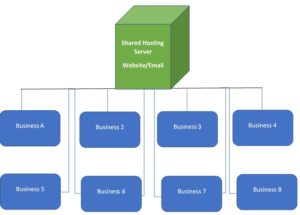Email is at the very core of how businesses communicate today. Due to the availability and adoption of the internet in the corporate workplace, email has quickly risen to surpass written, telephone, and fax communication. It has become the primary mode of day-to-day and legally-binding business communication. This is why businesses need to ensure their email solution is efficient, optimal, reliable, and cost-effective.
A frequently asked question around email management is, “Which solution is more reliable, cost effective and efficient between on-premise/self-hosted and third-party cloud-hosted email?”
Businesses are often faced with a dilemma. This is whether to move their emails to the cloud or to host and manage them within their business premises.
In this article, we share our first-hand experience with email management through our research. We have also interacted with hundreds of business owners, IT managers, consultants and employees. We found that many experience the following challenges while running on-premise email servers.
Related article: 4 Questions to Ask Yourself Before Moving from an On-Premise Email Server to the Cloud
1. Types of Email Hosting Options
We have different email hosting options. These are:
- Shared hosting – This is where an organization hosts its email on the same server as their website. This server is shared with other organizations who use it for similar purposes. This is not an ideal cloud-hosted email solution for various reasons. We will not discuss these in this article. For more information on shared hosting, click here.
- On-premise/self-hosted – This is where an organization installs and manages their own mail server within their location. We will discuss this later in this article.
- Third-party email service provider/cloud-hosted– This is where a third-party service provider who specializes in hosted email solutions hosts email on behalf of an organization. These providers have many years of experience and expertise in managing email and collaboration tools.
2. Challenges of On-Premise Email/ Self-hosted Email
While it is possible to run your own internal email server, it is often not the best option for a variety of reasons. Research consistently shows that businesses running on-premise email servers consistently encounter one or more of the following challenges or limitations:
i. High direct and indirect costs
There are high direct and indirect costs of managing and maintaining an on-premise email server including but not limited to: –
- High capex; high capital expenditures are incurred when new servers need to be purchased. This can be as a result of hardware end-of-life, limited storage, limited processing capacity, or just the need for upgrade to ensure optimal performance
- High, unpredictable recurrent support costs: Because every on-premise installation is customized and may include solutions from multiple vendors, it may become difficult and/or expensive to support each solution. Some may require specialized skills that may not be present in-house.
- Often, these are costs which cannot be predicted as they have to be analyzed as need arises. For example, if the on-premise mail server crashes, any number of different components within your organization including other servers that host Active Directory (user accounts/security), DNS Internet Connections and firewalls may require maintenance. This often means that the business and staff are unable to access their email during this time.
- Constantly depreciating or dead assets: on average, many organizations with on-premise servers often remain with fixed, static technology for a period of five years. During a refresh or upgrade, these become dead assets in the organization.
- Monitoring costs: To minimize interruption, some organizations deploy automated tools to monitor service and infrastructure uptime and also provision a team to work in shifts to monitor and maintain these setups;
- Cost of backup offsite equipment: Ensuring business continuity by replicating email to a secondary offsite server is an expensive proposition that is often beyond the reach of many organizations.
- Because of the criticality of email in businesses, to minimize downtime, some organizations are forced to acquire and maintain a backup internet link for redundant email connectivity.
- New businesses’ initial cost of onboarding is high because it often demands a large initial investment in hardware, software, and associated licenses.
ii. Mail servers are complex to set up
For new businesses, the process of procurement, deployment, testing, and optimizing can mean that the business takes a long time to get started.
A typical email server consists of different software components. These include Mail Transfer Agent, Mail Delivery Agent, IMAP, and/or POP3 Servers. They work together to allow it to achieve its full functionality. Each component must be configured and tuned to work seamlessly to provide a fully-functioning mail server.
In addition to these components, you will probably also want to add spam filtering, antivirus and web mail components. Because they have so many moving parts, email servers can become complex and difficult to set up.
Some software packages include the functionality of multiple components. The choice of each component is often left up to the business decision-makers. In addition to the software components, mail servers need a domain name, the appropriate DNS records and an SSL certificate.
iii. Difficult system upgrades
Businesses are often faced with significant risk of data loss or major downtimes during system upgrades. With on-premise email solutions, upgrading systems is a complex process. Sometimes, it requires specialized IT teams to come in to perform or support the upgrade process.
v. Maintenance is time-consuming
There are the obvious maintenance tasks. For example, continuously keeping your antivirus and spam filtering rules, and all of the mail server components up to date. There is also the responsibility of backing up your email data. These issues become the responsibility of the business to resolve.
vi. Staying off blacklists
Keeping your email server off of the various blacklists, also known as DNSBL, blocklists, or blackhole lists remains a crucial task in managing your email server. These lists contain IP addresses of mail servers that were reported to send spam or junk mail (or for having improperly configured DNS records).
Many email severs subscribe to one or more of these blacklists and filter incoming messages based on whether the mail server that sent the messages is on the list(s). If your mail server is blacklisted, your outgoing messages may be filtered and discarded before they reach their intended recipients.
In the unfortunate event that your mail server is blacklisted, it is often possible to get it unlisted (or removed from the blacklist). This means you need to determine the reason for being blacklisted and then resolve the issue. After this, you will want to look up the blacklist removal process for the particular list that your mail server is on and follow it.
vii. Troubleshooting is difficult
The mere concept of resolving issues or tickets raised by users within your organization on why they are unable to send or receive email, or why their sent messages are not being received can sometimes be time consuming to troubleshoot. The larger the organization, the more time consuming this exercise becomes.
The issue may be caused by a misconfiguration in one of the many mail server components such as a poorly-tuned outgoing spam filter or by an external problem such as being on a blacklist. The process of narrowing down on the exact issue may sometimes take a lot of time to determine with certainty and fix.
viii. Difficult to scale
With on-premise servers, scaling often necessitates a re-architecture leading to downtimes, risk of data loss, and drop in productivity. In addition, scaling is often not easy due to long procurement cycles in some organizations.
ix. Frequent email downtime
Businesses have reported frequent downtime as a result of poor internet connectivity, power outages, or server hardware failure. In cases where this continues for a prolonged period of time, this may paralyze critical business operations.
x. Lower security
On-premise or self-hosted servers are reported to have frequent email bounce errors, spam, viruses, malware, emails going to spam/junk folder, email spoofing as well as a greater risk of user mailboxes being compromised. This increases the risk that an organization may be blacklisted on the internet.
xi. Increased risk of data loss
There is also increased risk of complete or partial data loss in the event of calamities such as fire, theft, floods, etc., where there is no offsite, regularly-tested backup of servers. While some businesses have backups, many of them attest to the fact that they are not sure whether these backups would work in the event of a disaster as many are not tested on a regular basis. Many companies do not have the right tools to help in monitoring and reporting failed backups for action.
xii. Synchronization limitations
Email in some cases may not synchronize across multiple devices (desktop PC, laptop, tablet or mobile devices).
xiv. Email delays
Organizations with self-hosted solutions report occasional delays when sending and receiving email.
xv. Lack of collaboration tools
On-premise servers usually lack collaboration tools such as file sharing, synchronization, and video/chat tools.
3. Conclusion
There are several downsides of on-premise or self-hosted email solutions which can spell disaster for many businesses.
For most decision-makers, it always seems cheaper and more secure to self-host the email systems. It is clearly not accurate to deem on-premise servers as cheaper.
Decision-makers often concentrate on the direct costs. They fail to recognize the indirect costs that make on-premise or self-hosting solutions notoriously costly and complex to procure, maintain and scale. Additionally, setting up and maintaining your own email server for most businesses is complicated and time consuming. The costs associated with managing and maintaining all the components in a mail server can run exponentially high in the long run.
4. The Alternative?
The myriad issues associated with on-premise or self-hosted servers has resulted in rapid growth in the number of businesses moving to the cloud. There is a lot to be gained from choosing a hosted email provider rather than managing your own in-house or self-hosted server. We discuss the benefits of moving to the cloud in this article.
Are you interested in MailSafi hosted email service or a hybrid integration with Microsoft 365/Google G-Suite?
If you would like to consider moving from your self-hosted solution to reap the benefits of cloud email hosting, MailSafi has two offerings for you to consider:
- A full MailSafi Email Hosting Solution, or
- A hybrid integrated solution of MailSafi + Microsoft 365/Google G-Suite.
Get in touch with us. You may also do a trial to see if our MailSafi hosted email service would be a good fit for your organization. Take advantage of our MailSafi Trial program to move a pilot group of your users to MailSafi. This will help you determine if our cloud email hosting is a good fit.
Contact us for more information.
![]()





Pingback: Cloud-Based Email Hosting for Business » The MailSafi Blog
Pingback: 15 Benefits of Email Archiving for Business » The MailSafi Blog
Pingback: Microsoft 365 + MailSafi Email Basic Hybrid | MailSafi [2020]
Pingback: What is Blacklisting? » The MailSafi Blog
Pingback: Google Workspace + MailSafi Email Hybrid | MailSafi [2020]
Pingback: 6 Reasons To Consider an On-Premise Mail Server | MailSafi
Pingback: Cloud Email Hosting for Business: The Benefits | MailSafi